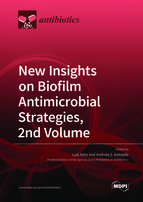New Insights on Biofilm Antimicrobial Strategies, 2nd Volume
A special issue of Antibiotics (ISSN 2079-6382). This special issue belongs to the section "Antibiofilm Strategies".
Deadline for manuscript submissions: closed (31 January 2022) | Viewed by 29750
Special Issue Editors
2. LABBELS–Associate Laboratory, 4710-057 Braga, Portugal
Interests: bacteriophages biofilms; prophagesstap hylococci; Helicobacter pylori
Special Issues, Collections and Topics in MDPI journals
Interests: multispecies biofilms; antibiotic agents; nucleic acid mimics; fluorescence in situ hybridization; human microbiota
Special Issues, Collections and Topics in MDPI journals
Special Issue Information
Dear Colleagues,
The first volume of the Special Issue “New Insights on Biofilm Antimicrobial Strategies” was published in the past year. It is a successful issue with 15 published papers and has encouraged us to open a second volume with the same topic.
As a continuation of the Special Issue published in 2020, this second volume will deal with different strategies to prevent biofilm formation or control development. The issue welcomes various submission types, such as original research papers, short communications, reviews, case reports, and perspectives.
Potential topics for this Special Issue include but are not limited to different antifouling strategies:
- Phages or phage-derived enzymes
- Use of physical approaches (photoporation; sonoporation)
- Development of antimicrobial peptides or nucleic acid mimics
- Use of natural products
- Modification of surfaces to prevent biofilm formation
- Combinations of antimicrobial agents with a synergistic effect
Dr. Luís Melo
Dr. Andreia Azevedo
Guest Editors
Manuscript Submission Information
Manuscripts should be submitted online at www.mdpi.com by registering and logging in to this website. Once you are registered, click here to go to the submission form. Manuscripts can be submitted until the deadline. All submissions that pass pre-check are peer-reviewed. Accepted papers will be published continuously in the journal (as soon as accepted) and will be listed together on the special issue website. Research articles, review articles as well as short communications are invited. For planned papers, a title and short abstract (about 100 words) can be sent to the Editorial Office for announcement on this website.
Submitted manuscripts should not have been published previously, nor be under consideration for publication elsewhere (except conference proceedings papers). All manuscripts are thoroughly refereed through a single-blind peer-review process. A guide for authors and other relevant information for submission of manuscripts is available on the Instructions for Authors page. Antibiotics is an international peer-reviewed open access monthly journal published by MDPI.
Please visit the Instructions for Authors page before submitting a manuscript. The Article Processing Charge (APC) for publication in this open access journal is 2900 CHF (Swiss Francs). Submitted papers should be well formatted and use good English. Authors may use MDPI's English editing service prior to publication or during author revisions.
Keywords
- biofilm prevention
- biofilm control
- surface modifications
- new generation antimicrobial compounds
- synergistic approaches








